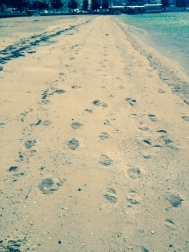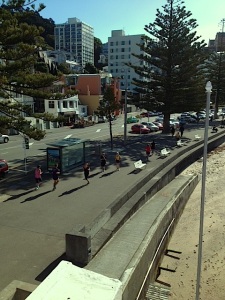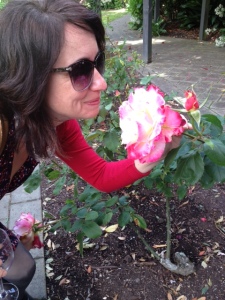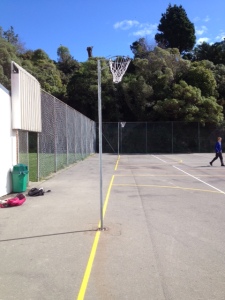


This blog post is dedicated to my 2013-2014 AP German students, who have taught me the importance of having a good sense of humor.
A few years ago, one of my students asked me how to use a certain German particle that shows up in conversation all the time…it was something like doch or mal. For readers who don’t know German: there are so many different uses of these two little words. Sometimes it’s hard to find a good definition for them, as it depends on what you want to express. For example, you can use doch to disagree with someone’s negative statement or to emphasize an idea, and you can use mal to add a touch of politeness to a statement or request.

Some of my amazing AP German students and myself right before they departed for university and I departed for NZ
I tried to provide my student with a clear, thoughtful explanation, but I could tell by the puzzled look on his face that I was not succeeding. So, I said, “well, it’s one of those things that you will learn when you go to Germany.”
Based on my prior language learning experience, I know that there are many confusing aspects of the language that become clear as soon as you are immersed in the culture and start interacting with people. Plus, I always want to send the message to my students that their learning doesn’t end the day they leave my classroom as high school students.
The student (along with all the other students in the class) thought my answer was hilarious. I never lived down my response. In fact, they managed to remind me of my “funny” response just about every other week for the next three years. I’m pretty sure this statement made it to the growing list they were compiling called “The funny things that Frau (Fellinger) says”.

These students also wrote down my “funny” quotes on dry erase boards and lined them up above the chalk board…many times I didn’t understand the humor, but at least they made the students laugh.
Relating to My Students: I have thought back to this interaction many times in the last two months as I make my journey through understanding a culture that is so new to me. Not just because I miss my students while I’m in New Zealand, but also because I am able to relate to their language learning frustrations. I am not faced with the challenge of negotiating my way through a non-English speaking culture, but I have experienced some interesting linguistic challenges. There is no way that I could truly internalize and begin to use certain Kiwi expressions before living here, but learning them in context makes all the difference. Some examples: “I’m keen to…”, “full on…”, “that’s alright” instead of “you’re welcome”, “protocol” instead of “etiquette”, “revise” instead of “review”, or my new favorite, “that’s really flash”….
The same goes for using certain Māori words and phrases for the appropriate occasion. Possibly, I could have learned these words and phrases necessary to understand and participate in a pōwhiri (welcoming ceremony). But would I have felt comfortable using them? No, definitely not. Not until I had been through the experience myself. I was told before departing for New Zealand that I would have to learn to sing a waiata if invited to a pōwhiri, but before living here for a few weeks I couldn’t grasp the importance of this gesture.
These may seem like little details. And some people may argue that I could survive in New Zealand without knowing them. However, I would say that these are important details. The more we interact with people, the more necessary it becomes to understand the nuances of language…. to avoid misunderstandings, to express politeness, to demonstrate respect, to send a heartfelt message…. And to gain a deeper understanding of the culture.
My Journey as Language Learner: I believe – or at least I hope – I have always had empathy for my students as language learners, because learning German did not come easy to me. I had to work really, really hard at it. And now I find myself in their shoes again as I try really, really hard to learn Te Reo Māori in a weekly evening class.
Two weeks ago I started my language journey. The class is offered every Wednesday – free of charge – to anyone who is interested in learning the language. It’s a thirty-minute commute to the Marae in which it takes place, but it’s worth it. Each class begins with about 15 minutes of speeches, prayers, and singing in Māori. I admit, during the first class, I felt a sense of panic come over me, afraid that I wouldn’t be coordinated enough to sing in a language that was completely new AND make the right movements at the same time! How could I read the lyrics with my limited knowlege of Māori pronunciation AND copy the movements of the person in front of me? But I realized the only way I would learn is by doing, and ultimately you can’t separate the language from the culture! And besides, as soon as we sat down with our learner group, the teacher for Beginners put me at ease with her gentle spirit, patience, and kindness.

Cuisenaire Rods (or rakau) for the Ataarangi Method (or also known as Silent Method). This method has been used to teach Te Reo Maori to adults for the past 30 years in New Zealand .
The language program uses the Ataarangi Method, which was introduced to New Zealand by Katerina Mataira over thirty years ago. I feel like a child again as I count the rakau (or rods) on the table and tell the teacher and fellow students the color of the rakau. I have now progressed to being able to say how many of the brown (or red, or white…) rakau are on the table. It’s a truly humbling experience, but at the same time it’s exciting and fascinating to be placed in the role of the language learner again. By the time I leave New Zealand, I realize, I still won’t be able to ask where the bathroom is or how to get to the bus stop in Te Reo Māori. However, I hopefully will be able to pronounce words or names that are used in every-day interactions more accurately. This is a sign of respect.
(Watch this cool Marae TVNZ video if you’re interested in learning the amazing success story of how the Ataarangi Method has helped to revitalize Te Reo Māori in New Zealand.)

panels created by graduate students in Kura 301 (Understanding Māori Values and Culture). This is a course at Vic University, which all teachers in training are required to take.
My Journey as Teacher: I realize that the experiences along my journey as language learner are key to developing my practice in helping students to develop their intercultural* competence. They have reminded me what it’s like to be the learner. It can be terrifying. It can be embarrassing. It can be confusing. I’ve certainly made some mistakes along the way. But it can also be exciting, rewarding, and fun. And it is a key to gaining new perspectives and insights into the culture.
These experiences have also reinforced some of the principles that I have always seen as key in language teaching and learning. First, and in my opinion most importantly, we can’t separate the language and the culture. Students will not learn from memorizing a long list of vocabulary words. They have to learn the language in a meaningful context. The best case scenario would be, of course, if every learner could be immersed in the target culture for an extended period of time. But the reality is that this opportunity is not always possible or available to all learners. Therefore, it is the responsibility of teachers to provide that context for their students (by simulating situations from the target culture, using authentic materials, providing access to the target culture through online partnerships with students in other countries, etc.).
The second principle is that students need to play an active role in their learning. One way to do this is to encourage students to explore the answers to their own questions. I believe we teachers put a lot of pressure on ourselves to know and understand everything, especially language teachers. Teaching language requires language proficiency, but it doesn’t require us to know every single word in the dictionary (despite what our students might believe about us having super-human language abilities). In the university courses that I visited at the beginning of my program here, I noticed a recurring question: “who has access to knowledge in the classroom?”. I have reflected on this question as it relates to the language classroom. In a classroom in which students are learning the language in context, they should be encouraged to seek the knowledge and to make discoveries through deeper learning opportunities. In order to develop intercultural competence, they will need to know how to think critically and problem solve.
So, I think back to my story at the beginning of the post. I wonder why my students found it so funny when I said, “it’s one of those things that you will learn when you go to Germany”. I could chalk it up to silly teenage humor. But now I think maybe it was because they aren’t used to teachers admitting they don’t possess the magical key to knowledge.
My stay in New Zealand is half-way over, but I know that my journey in developing my own intercultural competence and helping my students to develop theirs is constantly evolving. I look forward to finding out where this journey will take me during the second half of my stay.
* To reflect the research and practices in New Zealand language education, I am now using the terminology “intercultural competence” in place of “global competence”.

















































